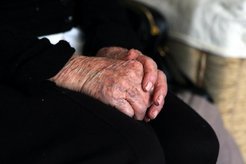The virus in our political and economic systems - Part 2
Autor: Mark Harvey
Care homes
Care homes reflect a major political and economic fault line, different but nonetheless concordant with a political economy failing to regulate labour markets and the interface between the public and private sector. At the outset of the arrival in Britain of the pandemic, there was a suspicion that the elderly in care might be treated as a dispensable constituent of the population. Care homes were already in crisis, with many facing bankruptcy. Decades of political failure to integrate care provision within the National Health Service combined with a chronic fault line in financing care homes and elder care.

There was a lack of any social insurance system, and the burden of financing those who could not afford their own care fell on local authority government which had been financially squeezed to the point of governmental insolvency. The provisioning system was predominantly privatised, some places being purchased by local authorities, with cross-subsidisation from private places. In 2017, the care sector was worth £15.9 billion, with 95% of provision by the private sector. The average charge for the self-funding resident was £824 per week accounting for 49% of residents, and £621 per week for the 41% of Local Authority supported residents, means tested and also often partly self-funded (Competition and Markets Authority Report, November 2017).
The staffing of care homes is characterised by low pay, many on the minimum wage. When the minimum wage was raised, the pincer-financial squeeze on private provisioners and local authorities intensified. Moreover, this low paid segment of care provision was heavily dependent on Eastern and Southern European workers. The care system benefitted from European Union free movement to establish this discriminatory and exploitative form of employment. In the latest official statistics, social care workers aged 20 to 64 are shown to be twice as likely to die of Covid-19 than either health care workers or their cohort in the general population.
In short, the care provisioning system was an incoherent and broken default system waiting for a cataclysm to happen. It was therefore not at all accidental that the hospitals were given priority over care homes both in terms of Personal Protective Equipment and testing for the virus. Care homes were already prefigured as last in the queue. Infected patients in hospital were transferred to care homes to protect the hospitals, so spreading the epidemic into them. A crime. In this sense, the fact that care homes now account for between a third and a half of all Covid 19 deaths is no accident or surprise. A fraction of the population – roughly 500,000 – has contributed a major proportion of fatalities. The political, financial and social conditions already in place predestined this horrific outcome.
Two societal fault-lines have been exposed by Covid-19, the first producing a fiscal scandal and immediate destitution for millions, the second resulting in Death in the Care Homes. The government responses to the pandemic have been shambolic, delaying lockdown, failing to have reserves of Personal Protective Equipment, lacking a capacity to test for the virus – the list goes on. But these two short pieces reveal how the pandemic is unravelling a deeper level of political and economic failure, the decadal entrenchment of an insecurity society based on an inadequate fiscal and legal regime. The disunited kingdom is a doubly insecurity society, living a precarious life at work, facing financial and social vulnerability in old age. At some point, one hopes there will be a comparative analysis of the sociogenesis of the Covid 19 pandemic, to expose and transform our variously flawed political and economic systems.
